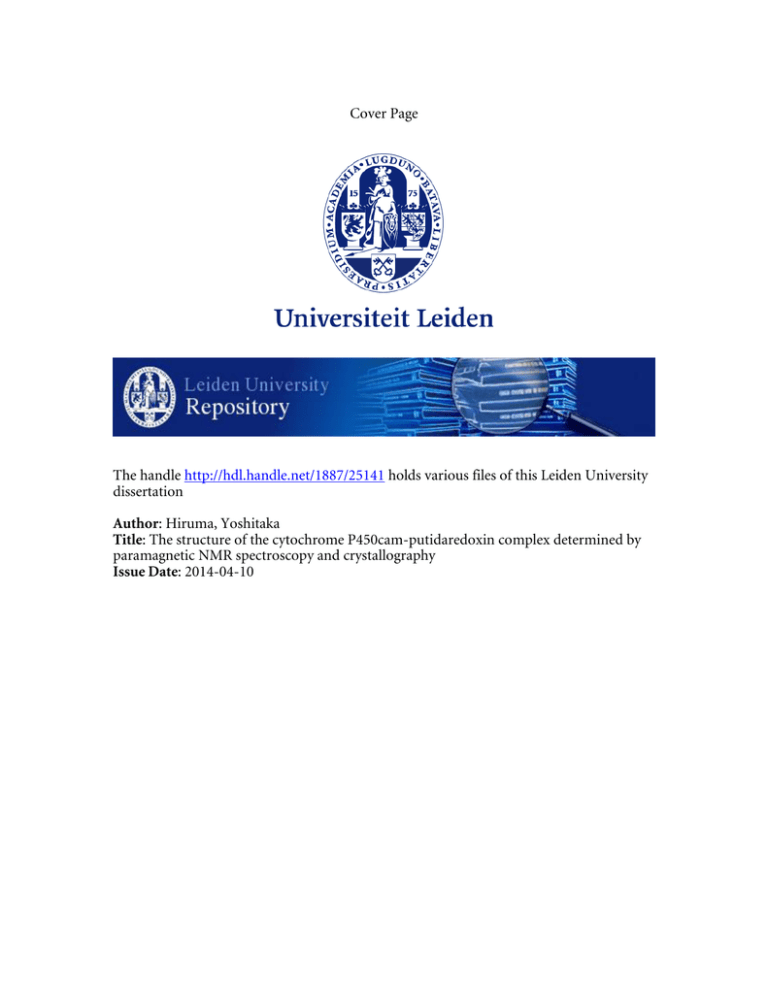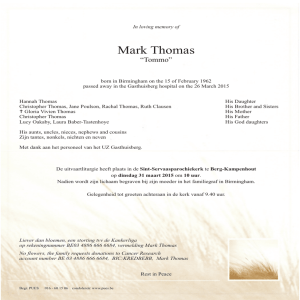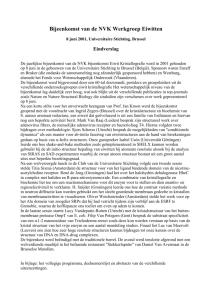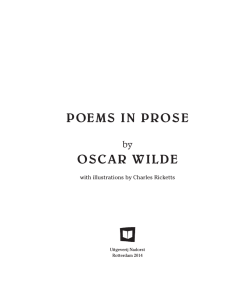Cover Page The handle http://hdl.handle.net/25141 holds
advertisement

Cover Page The handle http://hdl.handle.net/1887/25141 holds various files of this Leiden University dissertation Author: Hiruma, Yoshitaka Title: The structure of the cytochrome P450cam-putidaredoxin complex determined by paramagnetic NMR spectroscopy and crystallography Issue Date: 2014-04-10 Addendum Summary Samenvatting Publication list Curriculum Vitae Acknowledgements Addendum Summary Among the 15,000 reported cytochrome P450s, the best characterized P450 family member is P450cam (CYP101A1). The aim of the research described in this thesis is to advance our understanding of the mechanisms of P450cam-ligand interactions. The results of the studies provide general insights into P450 systems, since their catalytic mechanisms are closely related to that of P450cam. Chapter 1 provides a general introduction about the P450 superfamily, the catalytic cycle and electron transfer partners of P450cam as well as paramagnetic NMR methods. In chapter 2, a study is described in which a paramagnetic NMR probe, CLaNP-7, was attached at multiple sites of P450cam and Pdx to determine the structure of their complex in solution. The size and orientation of Δχ tensors of Ln3+-CLaNP-7 and the metal positions were experimentally determined by pseudocontact shift (PCS) analysis. Out of twelve P450cam constructs, six P450cam mutants were produced. The other six constructs yielded very little protein and therefore, it was decided not to use them for CLaNP-7 labeling. The low yield of P450cam constructs was attributed to the substitution of double Cys mutations, which apparently leads to instable or incorrectly folded protein in some cases. The Δχ tensors derived from the experimentally obtained PCS suggested that all of the mutants were labeled with CLaNP-7 via two arms, except for P450cam mutant F (A113C/N116C). Fitting of the Ln3+ position based on the PCS showed that CLaNP-7 was anchored at P450cam mutant F via a single disulfide bond. Two of the mutants were found either too close or far away from the Pdx binding site. In total, four out of twelve mutants were used for the calculations, which indicates that designing probe positions on protein contains the elements of trial and error. These results form the prelude for the intermolecular paramagnetic NMR experiments to study Pdx-P450cam complex, which are discussed in chapter 3. In this chapter the structure of the oxidized Pdx-P450cam complex in solution is reported, based on a set of 446 restraints for structure calculation obtained by PCS, PRE and RDC analysis. After the structure had been determined, our collaborators also solved the crystal structure of the complex. The solution structure based on paramagnetic restraints is represented by an ensemble of ten structures with an average RMSD from the mean of 1.3 Å for the position of Pdx. The position for Pdx relative to P450cam observed in the crystal structure is identical to the one in the solution structure within the experimental precision of the ensemble. These results demonstrate the accuracy of the paramagnetic approach for structure determination. The structure demonstrated that the metal centers are 16Å away, allowing for a sufficiently fast ET. Two coupling pathways could be distinguished, connecting the FeS cluster to the conjugated heme ring system and iron, respectively. Strikingly, our structure of the Pdx-P450cam complex differs from the previously proposed model by Zhang et al. While our manuscript was under review, Tripathi et al. published the crystal structure of the Pdx-P450cam complex that was obtained via cross linking of the two proteins. Tripathi et al. found that P450cam is present in a state that resembles & 127 Addendum the open state of P450cam. On the basis of this observation, they concluded that the nature of effector role of Pdx is to cause a conformation change in P450cam from the closed to open state. Further NMR experiments that are able to distinguish between the open and closed states of P450cam in the complex are required to establish whether Pdx binding causes the opening of P450cam also in solution. The importance of the interactions of polar residues that were newly identified to be part of the interface of the Pdx-P450cam complex, is demonstrated by mutagenesis and kinetic experiments (Chapter 4). These polar interactions contribute to partner recognition but do not influence the electron transfer rates. In the Chapter 5, we have characterized the encounter state of the Pdx-P450cam complex using paramagnetic data from additional probes. The results of PCS and RDC analysis support the previously determined structures of the complex. At the same time the distance restraints derived from PRE showed significant deviations from the expected values for some probes. It is concluded that a small fraction of the complex exhibits a dynamic nature. In the encounter state Pdx is localized close to the J and K helices as well as the β1 sheet. These regions all have basic and hydrophobic residues clustered together. Previous mutagenesis studies as well as X-ray crystallography demonstrated that the interactions of Pdx and P450cam are dominated by polar interactions, hydrogen bonding and hydrophobic contacts. Given the overall negative charge of both proteins, it is reasonable to assume that Pdx visits mostly basic/ hydrophobic patches of the P450cam surface. The lowly populated encounter complex could be relevant to the formation of the final Pdx-P450cam complex. The prominent basic patches compose a path to guide the Pdx to the putative binding site. Thereby, it reduces the three-dimensional search via collisions to a two-dimensional search on the P450cam surface. Moreover, the charge interaction prolongs the lifetime of the encounter facilitating the formation of the ET active complex. The paramagnetic substrate analogue, 1-PIM-3-para, was used to characterize the substrate access channel of P450cam (Chapter 6). The crystal structure of P450cam bound to 1-PIM-3 exhibits a more open conformation than that of substrate-free form. The preliminary results of the PRE analysis indicate that paramagnetic ligand analogues can be used to characterize protein-ligand complexes. This work demonstrates the proof-of-principle that small paramagnetic centers attached to ligands rather than protein can be helpful to characterize a complex. In conclusion, by utilizing paramagnetic NMR techniques, the structure and dynamics of the P450cam system were investigated. The analysis of PCS and RDC illuminated the stereo-specific final complex of Pdx and P450cam, while the results of PRE demonstrated the presence of a transient encounter complex. Furthermore, the significant insights of the interaction in the interface were uncovered by X-ray crystallography. Currently, the nature of Pdx effector activity is under debate. Since paramagnetic NMR experiments are applicable to solution studies at ambient temperature, PCS, RDC and PRE methods can further resolve the molecular mechanism of P450cam in the future. 128 Addendum Samenvatting Van de 15.000 in de literatuur vermeldde cytochromen P450, is P450cam (CYP101A1) het best gekarakteriseerd. Het doel van het onderzoek dat wordt beschreven in dit proefschrift is het vergroten van onze kennis van het mechanisme van interacties tussen P450cam en liganden. De resultaten van de studies geven een algemeen inzicht in P450 systemen, aangezien hun katalytische mechanismen nauw verwant zijn aan dat van P450cam. Hoofdstuk 1 geeft een algemene inleiding over de P450 superfamilie, de katalytische cyclus en elektronenoverdrachtpartners van P450cam alsmede over paramagnetische kernspinresonantie (Nuclear Magnetic Resonance, NMR) technieken. In Hoofdstuk 2 wordt een studie beschreven waarin een paramagnetische NMR sonde, CLaNP-7, is aangebracht op verschillende plaatsen op P450cam en Pdx om de structuur te bepalen van hun complex in oplossing. De grootte en oriëntatie van de Δχ-tensors van Ln3+-CLaNP-7 en de positie van het metaal zijn experimenteel bepaald door analyse van pseudocontact verschuivingen (pseudocontact shift, PCS). Van twaalf P450cam constructen zijn zes mutanten geproduceerd. De resterende constructen gaven een te lage eiwitopbrengst en zijn daarom niet gebruikt voor Caged Lanthanide NMR Probe (CLaNP) aanhechting. De lage eiwitopbrengst van de P450cam-constructen is te wijten aan het aanbrengen van dubbele cysteïne mutaties, die in sommige gevallen kunnen leiden tot instabiele of incorrecte vouwing van het eiwit. De Δχ-tensorsen afgeleid uit de analyse van experimenteel verkregen PCS suggereren dat alle varianten CLaNP-7 binden via twee armen, met uitzondering van mutant F (A113C/N116C). Bij het bepalen van de Ln3+ -positie gebaseerd op PCS, is aangetoond dat CLaNP-7 met een enkele zwavelbrug is gebonden aan deze P450cam variant. Twee van de mutanten bleken een CLaNP-aanhechtingsplaats te hebben die zich te ver weg of juist te dicht bij de Pdx bindingsplaats bevond. In totaal zijn 4 van de 12 mutanten gebruikt in de berekeningen, wat aantoont dat het ontwerpen van de posities van de sonde een kwestie is van uitproberen. Deze resultaten vormen de inleiding tot de paramagnetische NMR-experimenten gebruikt om het P450camPdx complex te bestuderen zoals beschreven in hoofdstuk 3. In dit hoofdstuk wordt de structuur van het geoxideerde Pdx-P450cam complex in oplossing beschreven, gebaseerd op een set van 446 restraints voor structuurberekeningen, verkregen uit PCS, paramagnetische relaxatieversterking (Paramagnetic Relaxation Enhancement, PRE) en residuële dipolaire koppeling (Residual Dipolar Coupling, RDC) analyse. Nadat de structuur in oplossing was bepaald, hebben onze collega’s tevens de kristalstructuur van dit complex bepaald. De structuur in oplossing gebaseerd op paramagnetische NMR-gegevens wordt weergegeven door een ensemble van tien structuren met een gemiddelde RMSD van 1.3 Å voor de positie van Pdx. De positie van Pdx ten opzichte van P450cam zoals gezien in de kristalstructuur is identiek aan die in oplossing, gegeven de experimentele precisie van het ensemble. Deze resultaten tonen de nauwkeurigheid aan van een paramagnetische methode voor & 129 Addendum structuurbepaling. De structuur laat zien dat de metaalcentra zich 16 Å van elkaar bevinden, waardoor elektronenoverdracht met voldoende snelheid mogelijk is. Twee trajecten van elektronische koppeling konden worden bepaald, door de FeS cluster te koppelen aan respectievelijk de geconjugeerde heemring en de heemijzer. Onze structuur van het Pdx-P450cam complex wijkt af van de eerder voorgestelde structuur van Zhang et al. Terwijl ons manuscript werd beoordeeld voor publicatie, publiceerde Tripathi et al. de kristalstructuur van het Pdx-P450cam complex verkregen door de twee eiwitten te verbinden via een flexibel molecule. Tripathi et al. zagen dat P450cam in een toestand is die lijkt op de open vorm van P450cam. Gebaseerd op deze observatie concluderen zij dat het de functie is van Pdx om een conformationele verandering van de gesloten naar de open vorm bij P450cam te bewerkstelligen. Verdere NMR experimenten die onderscheid kunnen maken tussen de open en gesloten vorm van P450cam zijn nodig om te bepalen of binding van Pdx ook in oplossing het openen van P450cam veroorzaakt. Het belang van polaire residuen die zijn geïdentificeerd als onderdeel van het bindingsoppervlak van het Pdx-P450cam complex is aangetoond met behulp van mutagenese en kinetische experimenten (Hoofdstuk 4). Deze polaire interacties dragen bij aan partnerherkenning, maar hebben geen invloed op de snelheid van elektronenoverdracht. In hoofdstuk 5 wordt beschreven hoe wij de ontmoetingsstaat (encounter state) van het Pdx-P450cam complex hebben gekarakteriseerd door gebruik te maken van paramagnetische gegevens van aanvullende sondes. De resultaten van PCS- en RDCanalyse onderschrijven de eerder bepaalde structuren van het complex. Tegelijkertijd laten de experimentele afstanden verkregen met PRE significante afwijkingen van de verwachte waardes zien voor sommige sondes. Hieruit wordt geconcludeerd dat een klein deel van het complex dynamisch van aard is. In de ontmoetingsstaat bevindt Pdx zich dicht bij de J en K helices en de β1 sheet. Deze gebieden bezitten geclusterde basische en hydrofobe residuen. Eerdere mutagenesestudies evenals Röntgen kristallografie tonen aan dat de interacties tussen Pdx en P450cam worden gedomineerd door polaire interacties, waterstofbruggen en hydrofobe contacten. Gezien de algehele negatieve lading van beide eiwitten, lijkt het redelijk om aan te nemen dat Pdx voornamelijk de basische/hydrofobe delen van het oppervlak van P450cam bezoekt. Het ontmoetingscomplex kan relevant zijn bij het vormen van het uiteindelijke Pdx-P450cam complex. De prominent aanwezige basische delen aan het oppervlak vormen een pad die Pdx naar de vermeende bindingsplaats kan leiden. Hierdoor wordt een drie-dimensionale zoektocht door botsingen beperkt tot een tweedimensionale over het oppervlak van P450cam. Bovendien verlengt de ladingsinteractie de levensduur van de ontmoeting, wat de vorming van een elektronenoverdracht-actief complex vergemakkelijkt. 1-PIM-3-para is een paramagnetisch substraatanalogon en is gebruikt om het substraat-toegangskanaal van P450cam te karakteriseren (Hoofdstuk 6). De 130 Addendum kristalstructuur van P450cam gebonden aan 1-PIM-3 vertoont een opener configuratie dan de substraatvrije vorm. De eerste resultaten van PRE-analyse geven aan dat paramagnetisch ligand-analogen gebruikt kunnen worden om eiwit-ligand complexen te karakteriseren. Dit werk levert het proof-of-priciple dat kleine paramagnetische centra, gebonden aan liganden in plaats van aan eiwitten, zeer behulpzaam kunnen zijn bij het karakteriseren van een complex. Concluderend, door gebruik te maken van paramagnetische NMR technieken is de structuur en dynamiek van het P450cam-systeem onderzocht. De analyse van PCS en RDC heeft een stereospecifiek eindcomplex van Pdx en P450cam aan het licht gebracht, terwijl de resultaten van PRE de aanwezigheid van een kortlevend ontmoetingscomplex hebben aangetoond. Daarnaast is door gebruik te maken van Röntgen kristallografie significant inzicht verkregen in de interacties in het bindingsoppervlak van dit complex. Op dit moment staat de aard van de functie van Pdx ter discussie. Omdat paramagnetische technieken toepasbaar zijn op studies in oplossing bij kamertemperatuur, zijn PCS-, RDC- en PRE-methoden in staat in de toekomst het moleculaire mechanisme van P450cam verder op te lossen. & 131 Addendum Publication list Keizers, P.H.J.; Saragliadis, A.; Hiruma, Y.; Overhand, M.; Ubbink, M. (2008) Design, Synthesis, and Evaluation of a Lanthanide Chelating Protein Probe: CLaNP-5 Yields Predictable Paramagnetic Effects Independent of Environment. J Am Chem Soc 130, 14802–14812. Takahashi, I,; Kuroiwa, S.; Lindfors, H.E.; Ndamba, L.A.; Hiruma, Y.; Yajima, T.; Okishio, N.; Ubbink, M.; Hirota, S. (2009) Modulation of protein-ligand interactions by photocleavage of a cyclic peptide using phosphatidylinositol 3-kinase SH3 domain as model system, J Pept Sci 15, 411–416. Hass, M.A.S.; Keizers, P.H.J.; Blok, A.; Hiruma, Y.; Ubbink, M. (2010) Validation of a Lanthanide Tag for the Analysis of Protein Dynamics by Paramagnetic NMR Spectroscopy, J Am Chem Soc 132, 9952–9953. & Keizers, P.H.J.; Mersinli, B.; Reinle, W.; Donauer, J.; Hiruma, Y.; Hannemann, F.; Overhand, M.; Bernhardt, R.; Ubbink, M. (2010) A Solution Model of the Complex Formed by Adrenodoxin and Adrenodoxin Reductase Determined by Paramagnetic NMR Spectroscopy, Biochemistry 49, 6846–6855. Keizers, P.H.J.; Hiruma, Y.; Ubbink, M. (2012) Protein-Paramagnetic Protein Interactions. In: NMR of Biomolecules Towards Mechanistic Systems Biology: (Bertini, I., McGreevy, K.S. and Parigi, G., eds.) Wiley-Blackwell, pp. 204–217. Hiruma, Y.; Hass, M.A.; Kikui, Y.; Liu, W.M.; Olmez, B.; Skinner, S.P.; Blok, A.; Kloosterman, A.; Koteishi, H.; Löhr, F.; Schwalbe, H.; Nojiri, M.; Ubbink, M. (2013) The Structure of the Cytochrome P450cam-Putidaredoxin Complex Determined by Paramagnetic NMR Spectroscopy and Crystallography, J Mol Biol 425, 4353–4365. Hiruma, Y.; Gupta, A.; Kloosterman, A.; Olijve, C.; Olmez, B.; Hass, M.A.; Ubbink, M. (2014) Hot Spot Residues in the Cytochrome P450cam-Putidaredoxin Binding Interface, ChemBioChem 15, 80-86 133 Addendum Curriculum Vitae Yoshitaka Hiruma was born on the 15th of December 1983 in Tokyo, Japan. After obtaining his diploma in Soka high school in Tokyo, he decided to move to the U.K. to continue his education. He spent one year at University College London to pursue a British university entrance exam and enrolled in the University of Edinburgh in Scotland. In 2007, he obtained his BSc with honors in Biological sciences. He then moved to the Netherlands to pursue his MSc degree in Leiden University. Here, he joined the group of Prof. Dr. Marcellus Ubbink. Under the supervision of Dr. Peter Keizers and Hanna Lindfors, he completed his MSc thesis entitled “The characterization of protein interactions by NMR spectroscopy”. During the MSc study, he joined in the Erasmus exchange program and performed his second internship in Ludwig Maximilians University Munich, Germany. In 2009, he obtained his MSc degree in the department of Chemistry in Leiden University. He then joined in the Protein Chemistry group headed by Prof. Dr. Marcellus Ubbink as a PhD student. His research was focused on the characterization of the Pdx-P450cam complex formation by paramagnetic NMR spectroscopy. During his PhD degree, he collaborated with Dr. Masaki Nojiri in Osaka University, Japan. This led to the determination of the atomic resolution structure of the Pdx-P450cam complex by both paramagnetic NMR spectroscopy and X-ray crystallography, which is presented in this thesis. He joined the research groups of Prof. Dr. Geert Kops in the University Medical Center in Utrecht and Dr. Anastassis Perrakis in Netherlands Cancer Institute as a postdoctoral researcher in November 2013. In this collaborative project between both groups, he will perform his research concerning the biochemical characterization of the mitotic checkpoint machinery. & 135 Addendum Acknowledgements I would like to express my deepest gratitude to Prof. Dr. Marcellus Ubbink for providing me the opportunity to study for PhD as well as MSc degrees in his group. Over six years, I truly enjoyed being a member of his group and I was always very proud to present paramagnetic NMR techniques in a science conference. I am also deeply indebted to Dr. Peter Keizers who supervised me during my MSc project and introduced me to cytochromes P450. I have learned so many things from Peter and I would like to present this thesis to him with a sincere gratitude as one of his students. I also greatly appreciate the huge help provided by Dr. Mathias A.S. Hass, who shared his expertise throughout my PhD degree. I owe a big thanks to all members in Protein Chemistry group. Especially, I would like to acknowledge Anneloes Blok, who makes a wonderful research environment as well as plays a role as a sister/mother in the lab. Also I would like to thank Lionel Ndamba, who not only gave me technical support but also helped me to move my house. Whenever Lionel was around, I shared the progress of my experiments and my personal life without any hesitations. I am very grateful to Dr. Wei-Min Liu for synthesizing and providing me his paramagnetic NMR probes. Without his wonderful compound, CLaNP-7, my PhD project would never be fruitful. I would like to acknowledge BSc and MSc project students, Alexander Kloosterman, Caroline Olijve and Betül Ömez. While working together, I realized the solutions of many problems. Thanks also to Dr. Monika Timmer and Ingrid Bekooy, whose help was fundamental in and out of the laboratory. I am very fortunate to have had an outstanding collaboration with Osaka University in Japan during my PhD project. Dr. Masaki Nojiri, who shared his expertise of X-ray crystallography, solved the crystal structure of Pdx-P450cam complex. Masaki visited Leiden in 2011 and I was grateful to be able to introduce him and his family to the beauty of the historical Leiden city center. I would like to thank Ankur Gupta in Leiden Institute of Physics for technical support for stopped-flow experiments. I was shocked to see the computer operating the stopped-flow equipment, which dated back to 1990’s. I would also like to acknowledge Dr. Navraj Pannu and Dr. Igor Nederlof in Biophysical Structure Chemistry in Leiden Institute of Chemistry. Without their support, I would have never managed to perform X-ray crystallography. I am very thankful to the SGI Buddhist members in the Netherlands, who continuously encouraged me to go through my PhD degree. A particular thank goes to Olivier Hijmans, Ann Ferrara and Lianna Hartanto. At the final year of my PhD, my mother had a breast cancer. They provided me with a lot of support during that difficult time. I would like to mention my brother, mother and father, who brought me up no matter how difficult my childhood was. When I was in primary school, I never liked studying and my grades were horrifying. Today, I am going to present this thesis to & 137 Addendum my family for paying a debt of gratitude. And great thank goes to my wife, Mika Hiruma. Whenever I was disappointed at my experiments and my manuscript being rejected so many times from journals, Mika supported me without any doubts. She also introduced me to the top dermatologist in Japan. I was suffering so much from unknown allergic reactions in the Netherlands and I was used to wear white gloves on my bleeding hands. My allergic condition has dramatically improved since Mika came to my life. Last but not least, I am very thankful to my mentor, Dr. Daisaku Ikeda, who believes in my potential and gave me a dream to become a great scientist. 138


